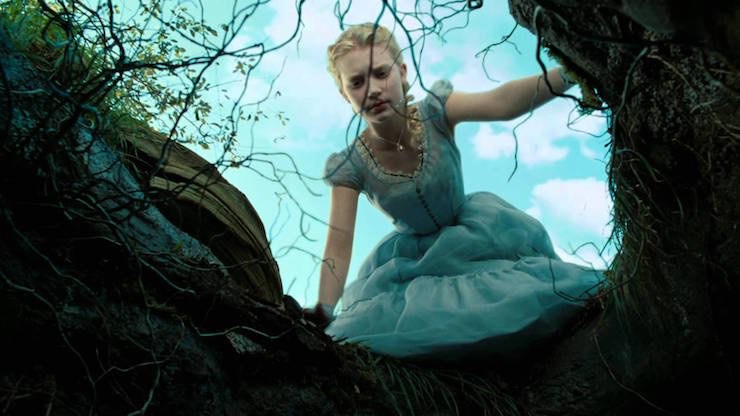I have a good friend who suffers from trypophobia, the fear of holes. (If you think you might have this, I don’t recommend Googling it, as right on top of the search results is a rather horrific array of “images for trypophobia.”) When my new novel, The Insides, came out, I had to apologize to this friend—going so far as to offer to personally hand-annotate her copy of the book with trigger warnings—because holes are at the very center of the narrative. The novel features a set of characters who use magic to cut holes into the fabric of time and space, and these holes don’t always behave as they should: sometimes they open or reopen unexpectedly, sometimes weird things come out of them.
The Insides is only the latest entrant in a long lineage of books featuring weird holes, portals, voids, and abysses, though: once you start looking for them, they seem to pop up everywhere. This might be bad news for trypophobes but it’s good news for readers who are looking for mysterious worlds to drop into.
Alice’s Adventures in Wonderland by Lewis Carroll
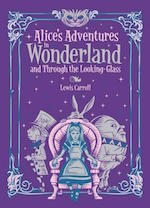 It’s hard to imagine a more quintessential plunge into the unknown than the one Alice takes into the rabbit-hole, way back in 1865. And the book wastes no time in getting us there: the very first chapter (“Down the Rabbit-Hole”) allows for only three paragraphs of exposition before Alice pursues the rabbit into the hole, “never once considering how in the world she was to get back out again.” A perfect model for steering a narrative into the inviting depths as quickly as possible.
It’s hard to imagine a more quintessential plunge into the unknown than the one Alice takes into the rabbit-hole, way back in 1865. And the book wastes no time in getting us there: the very first chapter (“Down the Rabbit-Hole”) allows for only three paragraphs of exposition before Alice pursues the rabbit into the hole, “never once considering how in the world she was to get back out again.” A perfect model for steering a narrative into the inviting depths as quickly as possible.
The Time Machine by H.G. Wells
 By contrast, this short classic takes a deliciously patient approach to building up to its inevitable descent. Wells’ Time-Traveller heads to the year 802,701, and famously finds a bucolic society of childlike beings, the Eloi. They live among a landscape of gradually degenerating futuristic architecture, but as the Traveller explores the area he begins to take a special interest in the mysterious shafts and airways he comes across… By now, everyone who really wants to know what’s down there already knows—it seems a bit silly to put a spoiler alert on a write-up of a book originally published in 1895—but the chapter wherein the Traveller first climbs a set of decaying ladder-rungs down into the darkness remains a masterpiece of delayed revelation and thrilling suspense.
By contrast, this short classic takes a deliciously patient approach to building up to its inevitable descent. Wells’ Time-Traveller heads to the year 802,701, and famously finds a bucolic society of childlike beings, the Eloi. They live among a landscape of gradually degenerating futuristic architecture, but as the Traveller explores the area he begins to take a special interest in the mysterious shafts and airways he comes across… By now, everyone who really wants to know what’s down there already knows—it seems a bit silly to put a spoiler alert on a write-up of a book originally published in 1895—but the chapter wherein the Traveller first climbs a set of decaying ladder-rungs down into the darkness remains a masterpiece of delayed revelation and thrilling suspense.
The Dungeon Master’s Guide by Gary Gygax
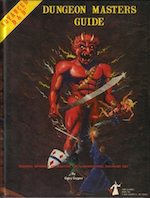 The “dungeons” of classic Dungeons and Dragons are basically just holes in the ground. And yet they’re also so much more. The sixteen Appendices in the first edition DMG provide any aspiring Dungeon Master with the tools necessary to take any generic pit and embellish it into a dense maze of passages, chambers, and secret doors, stocked with monsters, loot, and random claptrap (for this last, allow me to refer you to Appendix I, “Dungeon Dressing: Miscellaneous Items and Points of Semi-Interest for Corridors and Unpopulated Areas or To Round Out Otherwise Drab Places”). I’ve had this book since I was probably ten years old and I can think of no book that’s a better guide to the endlessly generative imaginative potential of the subterranean.
The “dungeons” of classic Dungeons and Dragons are basically just holes in the ground. And yet they’re also so much more. The sixteen Appendices in the first edition DMG provide any aspiring Dungeon Master with the tools necessary to take any generic pit and embellish it into a dense maze of passages, chambers, and secret doors, stocked with monsters, loot, and random claptrap (for this last, allow me to refer you to Appendix I, “Dungeon Dressing: Miscellaneous Items and Points of Semi-Interest for Corridors and Unpopulated Areas or To Round Out Otherwise Drab Places”). I’ve had this book since I was probably ten years old and I can think of no book that’s a better guide to the endlessly generative imaginative potential of the subterranean.
As a bonus, there are a surprising number of hole-themed magical items enumerated in the DMG, ranging from the handy Portable Hole (which is basically exactly what it sounds like) to the menacing Sphere of Annihilation (“a globe of absolute blackness, a ball of nothingness … a hole in the continuity of the multiverse”). Ask any D&D player, though, and they’ll tell you that their favorite is the humble Bag of Holding—a bag bigger on the inside than it is on the outside. This is pretty clearly designed only to allow players to stuff themselves with more gold than they could possibly realistically carry, but Gygax’s wonderfully purple prose invests even this blatant contrivance with over-the-top majesty and weirdness: he mentions offhandedly that if the bag should be damaged “the contents will be lost forever in the vortices of nilspace.” The “vortices of nilspace” is the kind of evocative phrase that I might be able to come up with after laboring for an hour; I kinda feel like Gygax could spin off a dozen like it before he got out of bed in the morning.
The Kefahuchi Tract trilogy (Light, Nova Swing, and Empty Space) by M. John Harrison
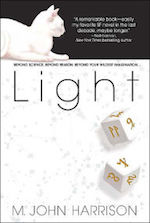 I pulled the epigraph for The Insides from Nova Swing, the middle volume in this science fiction trilogy. At first glance the books in this trilogy could be described as “space opera”—they’re full of cool starships, gratuitous space battles, and the like—but to describe them that way runs the risk of glossing over Harrison’s deep obsession with the strange. The strangeness centers around the Kefahuchi Tract, an incomprehensible anomaly out in deep space. It might be a hole—it’s described as a thing you could enter—but other times it’s described as being like an agglomeration of light and still other times it’s described as being more like a bunch of cryptic mathematics. In the end it’s not quite like anything: it’s filled with “long secrets,” it heaves “with some emotion you couldn’t recognize.” Harrison uses the Tract to delve into the way that voids wreak havoc on us psychologically, the way staring into an abyss for too long can make a human being go odd and desperate.
I pulled the epigraph for The Insides from Nova Swing, the middle volume in this science fiction trilogy. At first glance the books in this trilogy could be described as “space opera”—they’re full of cool starships, gratuitous space battles, and the like—but to describe them that way runs the risk of glossing over Harrison’s deep obsession with the strange. The strangeness centers around the Kefahuchi Tract, an incomprehensible anomaly out in deep space. It might be a hole—it’s described as a thing you could enter—but other times it’s described as being like an agglomeration of light and still other times it’s described as being more like a bunch of cryptic mathematics. In the end it’s not quite like anything: it’s filled with “long secrets,” it heaves “with some emotion you couldn’t recognize.” Harrison uses the Tract to delve into the way that voids wreak havoc on us psychologically, the way staring into an abyss for too long can make a human being go odd and desperate.
I Go to Some Hollow by Amina Cain
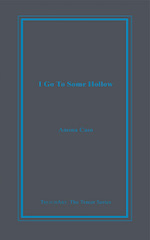 Around the same time I was reading M. John Harrison’s trilogy, I also was reading the short stories of the experimental writer Amina Cain. Like Harrison, she too is interested in the oddness of human beings. Ordinarily, we think that we are defined by what we are, but Cain’s short, enigmatic stories brilliantly demonstrate that our identity can be just as much a product of what we aren’t—that our personalities, in some ways, are defined by holes: gaps, absences, blind spots, cracks, crevasses. Her short story “Aviary,” which appears in her early collection I Go to Some Hollow, literalizes this—it features a woman who inhabits an ambiguous psychological state, living in a cabin next to a hole which mysteriously appears one day. “This isn’t a swimming hole,” she remarks cryptically, to an older man on the phone. “There’s no water inside.” Her more recent collection, Creature, (available from Dorothy, a publishing project, one of my favorite small presses) explores similar territory: my copy of it is full of underlined sentences like “Time opens up and something is wrong,” which aptly captures a particular sort of psychological distress, the horror of something yawning wide in the mind. Trypophobia indeed! Cain’s not writing genre work the way many of the other authors on this list are, but her deliriously riddled writing is as wonderfully disorienting as the best science fiction or fantastic literature.
Around the same time I was reading M. John Harrison’s trilogy, I also was reading the short stories of the experimental writer Amina Cain. Like Harrison, she too is interested in the oddness of human beings. Ordinarily, we think that we are defined by what we are, but Cain’s short, enigmatic stories brilliantly demonstrate that our identity can be just as much a product of what we aren’t—that our personalities, in some ways, are defined by holes: gaps, absences, blind spots, cracks, crevasses. Her short story “Aviary,” which appears in her early collection I Go to Some Hollow, literalizes this—it features a woman who inhabits an ambiguous psychological state, living in a cabin next to a hole which mysteriously appears one day. “This isn’t a swimming hole,” she remarks cryptically, to an older man on the phone. “There’s no water inside.” Her more recent collection, Creature, (available from Dorothy, a publishing project, one of my favorite small presses) explores similar territory: my copy of it is full of underlined sentences like “Time opens up and something is wrong,” which aptly captures a particular sort of psychological distress, the horror of something yawning wide in the mind. Trypophobia indeed! Cain’s not writing genre work the way many of the other authors on this list are, but her deliriously riddled writing is as wonderfully disorienting as the best science fiction or fantastic literature.
Tope image: Alice in Wonderland (2010)
 Jeremy P. Bushnell is the author of the widely praised debut The Weirdness. His second novel, The Insides, was just published by Melville House. He teaches writing at Northeastern University in Boston, and lives in Dedham, Massachusetts.
Jeremy P. Bushnell is the author of the widely praised debut The Weirdness. His second novel, The Insides, was just published by Melville House. He teaches writing at Northeastern University in Boston, and lives in Dedham, Massachusetts.










